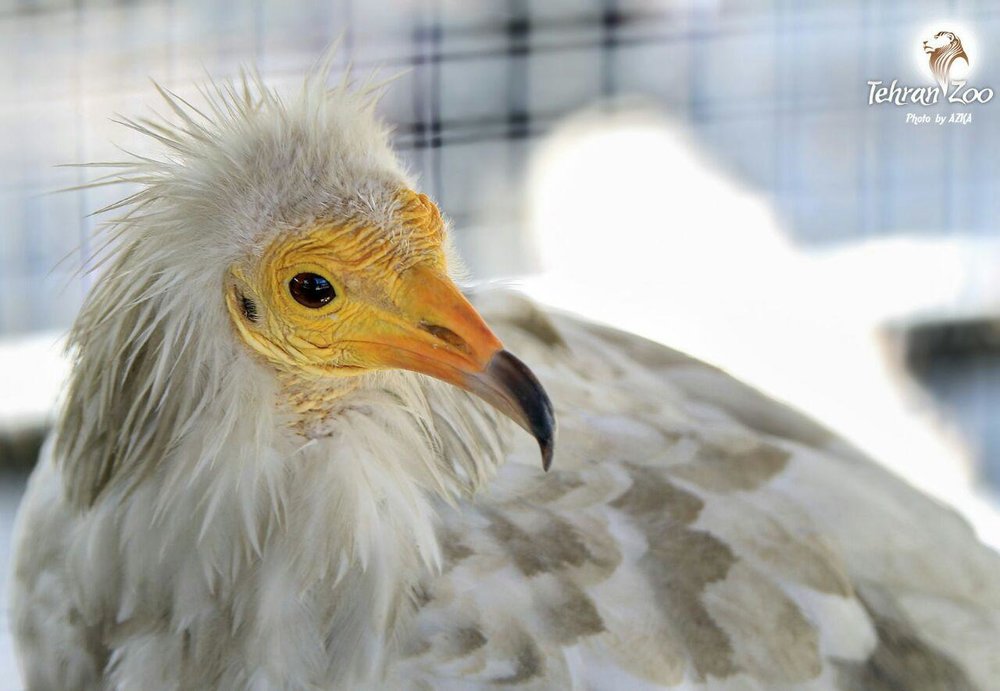Birds of prey: Egyptian vulture

Including some of Iran’s biggest birds, the vultures soar high up, using superb eyesight to spot potential food on the ground: they eat meat, preferably freshly dead animals. They need warm, rising air or up-draughts and live in mountainous areas. Vultures, such as Egyptian Vulture, have very long wings, soaring on warm air with little expenditure of energy.
The photo depicts a mature Egyptian Vulture that lives at Tehran Zoo. This species is categorized as an endangered species. Egyptian Vulture is native in Iran and also in other countries such as Afghanistan, Armenia, Azarbaijan, Bulgaria, Central African Republic, Egypt, Eritrea, Ethiopia, France, Greece, Guinea, India, Italy, Kazakhstan, Morocco, Namibia, Nepal, Nigeria, Oman, Pakistan, and also Palestinian Territory.
The Egyptian vulture’s hooked bill is too weak to break into a large carcass without the aid of other large vultures. However, its long bill is ideal for breaking eggs, one of its favorite foods. In contrast to this bird’s fine head plumage, other vultures have bare heads and necks. This prevents them from covering their feathers with blood when they reach deep inside a carcass to feed.
Distribution in Iran
Vultures have 6 species in Iran, including Black or Monk Vulture, Griffon Vulture, Egyptian Vulture, Lammergeier or Bearded Vulture, Indian White-backed Vulture and Short-toed Eagle.
Egyptian Vulture is the smallest, more the size of a medium sized eagle but markedly larger than the buzzards. Juveniles have dark brown body with pale feet. But older immature gains white with age. Adult Egyptian Vulture in flight has white forewings and white tail. Narrow head, yellow face, untidy ruff of spiky feathers, dirty white body, and brownish across upper-wings are the most spectacular keys for identification.
In Iran this species is abundant at summers but at winters are rare and some individuals are spotted in the South East. There is also no specific conservation plan for Egyptian Vulture in Iran.
The importance of vultures
The bill and talons of vultures such as other birds of prey, are well adapted for feeding on prey or scavenging on the remains of carcasses. Typically the bill is hooked and sharp. However, for vultures it is not generally used for killing, but for tearing flesh. Most birds of prey kill prey to eat, but many also scavenge on carrion (dead animals) when they find it. Vultures scavenge almost entirely on carrion. They have sharp, sturdy bills for slicing through hides and tearing at meat and sinews. Some of vultures have bared heads, and often their necks, naked of feathers to prevent them from becoming caked with blood. Their feet also are broad for walking, but weak and with flat claws, because they do not need them to kill. Vultures are noted for their high, soaring flight on long, broad wings. They ride on thermals- warm air currents rising from the ground. They can spot carrion many kilometers away with their excellent eyesight. Egyptian Vultures can use stones in their beaks to crack the hard shell of an egg. It might be smaller than other vultures, but it seems more intelligent. It is the only tool-user among birds of prey. Ostrich eggs are among its favorite food.
Specific characters
Egyptian vultures sometimes stand face to face on the ground in an elaborate courtship display. In addition to their ground- based display, the pair also perform spectacular aerial displays. They fly, climb and dive close together, often presenting their talons to each other. Egyptian Vultures can hide in thorny trees. Parents feed the chick on regurgitated liquids. Later, they regurgitate rodents, insects and snakes into the nest for the chick to eat. The chick is fully feathered in five weeks and stays in the nest for about a month longer.
Egyptian Vulture usually appears unmistakable. It is relatively common and dispersed over most habitats, even deserts, but seen mostly in mountainous regions as well as at refuse tips and slaughter-sites. This species in Europe has decreased partly as result of rationalization of waste- disposal methods. It is omnivorous and its diet includes carrion, household waste, excrement, insects, eggs and young of birds. It usually migrates in smaller flocks.
Threats
Two subspecies, nominate percnopterus over most of species’ range, specially Ginginiannus of India smaller with all-yellow bill in adult. Population is declining over most of its European range, owing to improved hygienic standards and decreased supply of suitable carrion. Now fewer than 2000 pairs in Europe with another 1000-7000 in Turkey. This species in South Africa is regionally extinct.
Number of threats exist in its range e.g. disturbance, lead poisoning, direct and secondary poisoning, electrocution (by powerlines), collisions with wind turbines, reduced food availability and habitat change are currently impacting upon European populations. Some reports pointed to higher declines of juveniles because of higher rates of mortality. Overgrazing in their habitats by livestock considered as a main threat for them in many countries such as Iran. But as mentioned before, there is absolutely no conservation plan for them in our country.
Leave a Comment